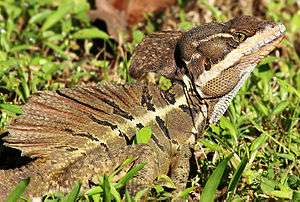Basiliscus (genus)
| Basilisks | |
|---|---|
 | |
| Brown basilisk, Basiliscus vittatus, Costa Rica | |
| Scientific classification | |
| Kingdom: | Animalia |
| Phylum: | Chordata |
| Subphylum: | Vertebrata |
| Class: | Reptilia |
| Order: | Squamata |
| Suborder: | Iguania |
| Family: | Corytophanidae |
| Genus: | Basiliscus Laurenti, 1768 |
| Species | |
|
Basiliscus basiliscus | |
Basiliscus is a genus of large corytophanid lizards, commonly known as basilisks, which are endemic to southern Mexico, Central America, and northern South America. They are commonly known as the Jesus Christ Lizard, or simply the Jesus Lizard, due to their ability to run across water for significant distances before sinking.
Taxonomy and etymology
Both the generic name, Basiliscus, and the common name, "basilisk", derive from the Greek basilískos (βασιλίσκος) meaning "little king". The specific epithet, vittatus, which is Latin for "striped", was given in Carl Linnaeus' 10th edition of Systema Naturae.[1]
Physiology
The basilisk has blue spots and a yellow iris, on average measures 70 to 75 mm (2.8–3.0 in), and weighs about 80 grams (3.2 oz). Its growth is perpetual, fast when they are young and nonlinear for mature basilisks. Its long crest-like sails, reinforced in three distinct points (head, back, and tail), confer the impression of creatures such as Dimetrodon and Edaphosaurus. Its skin is shed in pieces.
Running on water
The basilisk sometimes runs as a biped. Basilisks have the unique ability to "run" on water and, because of this, they have been dubbed as "The Jesus Christ lizard" in reference to the biblical passage of Matthew 14:22-34.[2] On water, the basilisk can run at a velocity of 1.5 meters (4.9 feet) per second for approximately 4.5 meters (14.8 feet) before sinking on all fours and swimming. Flaps between their toes help support the basilisk, creating a larger surface and a pocket of air. They can also sustain themselves on all fours while "water-walking" to increase the distance travelled above the surface by about 1.3 meters (4.3 feet).
Other defense mechanisms
The basilisk can burrow into sand to hide from predators; a ring of muscles around both nostrils prevents sand from entering the basilisk's nose.
Habitat
Abundant in the tropical rain forests of Central and South America, from southern Mexico to Ecuador and Venezuela. Recently introduced to Florida, it has adapted to the colder winters by burrowing into the leaf litter for warmth. Current reports sight the basilisk as far north as Fort Pierce, on the state's East Coast, where small groups have crept up the North Fork of the Saint Lucie River. Mainly they have been seen in Boca Raton and other cities in Palm Beach County. As recent as September 2015, a basilisk was spotted in a Miami residential neighborhood.
Classification
Genus Basiliscus
- common basilisk, Basiliscus basiliscus (Linnaeus, 1758)
- red-headed basilisk, Basiliscus galeritus A.M.C. Duméril & A. Duméril, 1851
- plumed basilisk, Basiliscus plumifrons Cope, 1876
- striped or brown basilisk, Basiliscus vittatus Wiegmann, 1828[3]
References
- ↑ Robert George Sprackland (1992). Giant lizards. Neptune, NJ: T.F.H. Publications. ISBN 0-86622-634-6.
- ↑ How "Jesus Lizards" Walk on Water. News.nationalgeographic.com. Retrieved on 2010-08-19.
- ↑ The Reptile Database. www.reptile-database.org.
External links
- Jesus Lizard Robot An attempt at building a robotic version of the Jesus Lizard
- How "Jesus Lizards" Walk on Water
- Jesus Lizards Walk on Water Video
- Jesus Christ Lizard Video